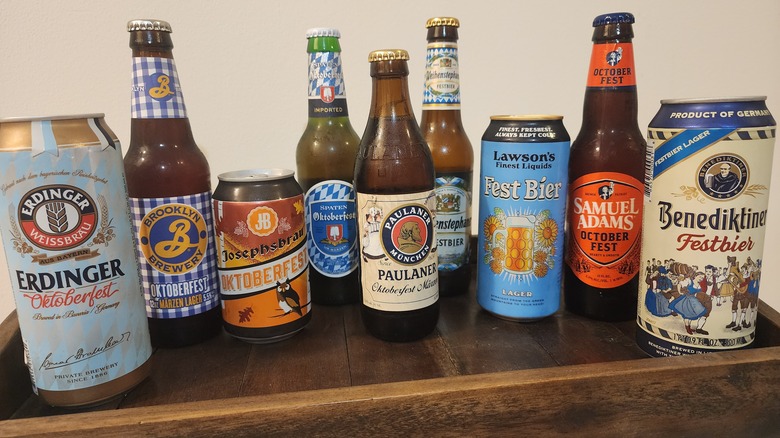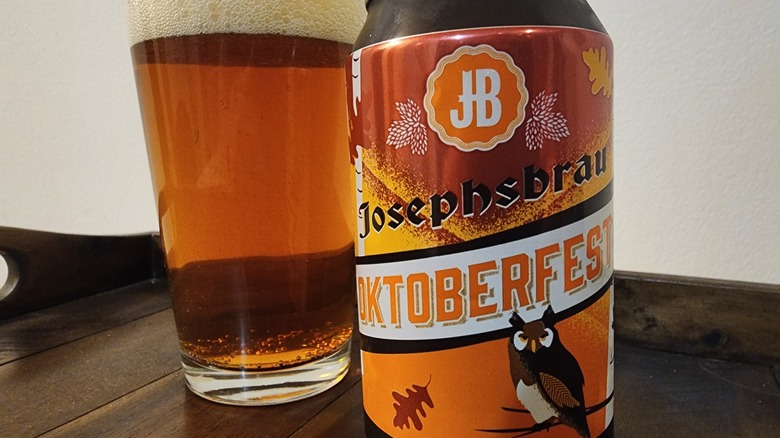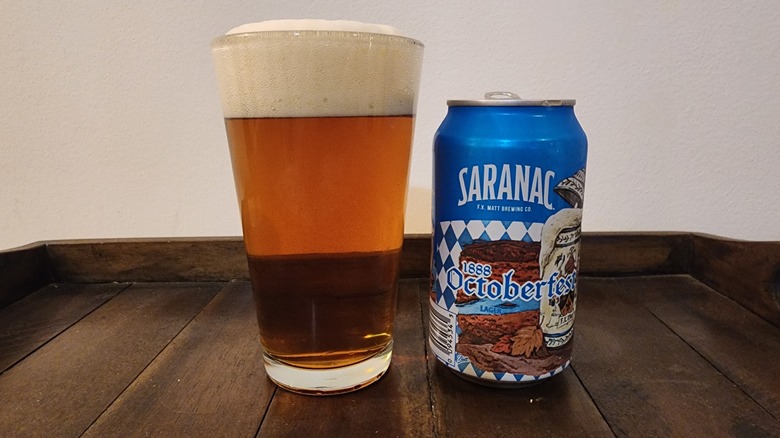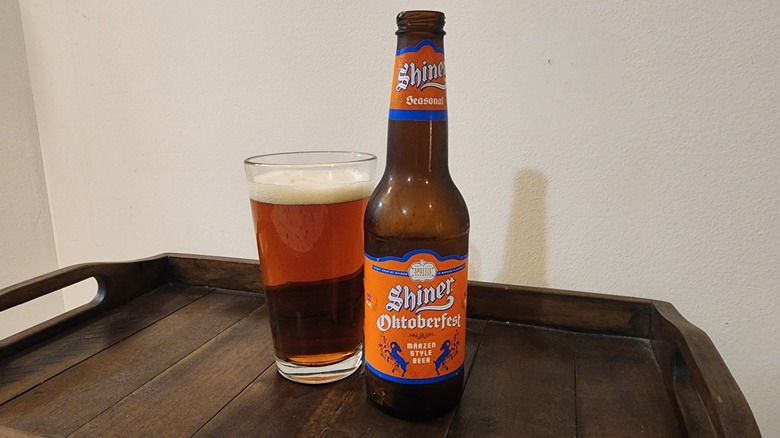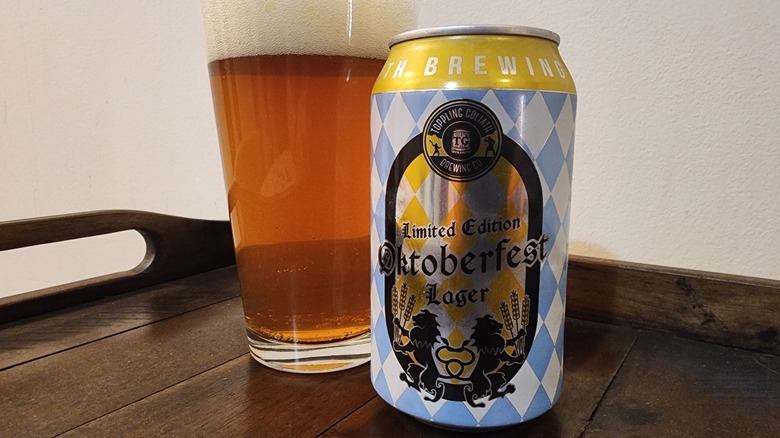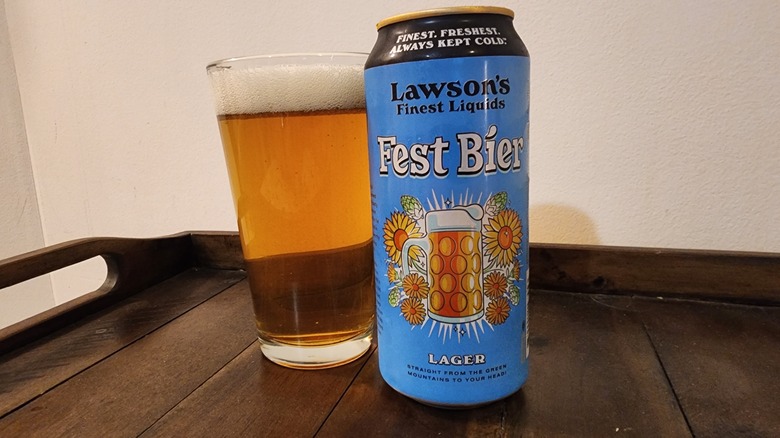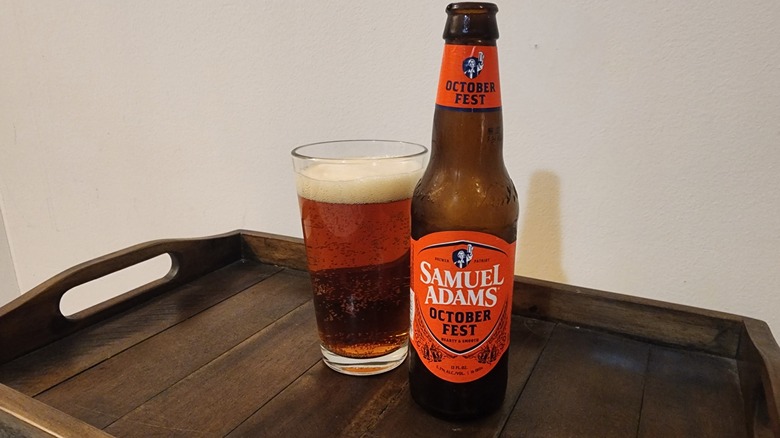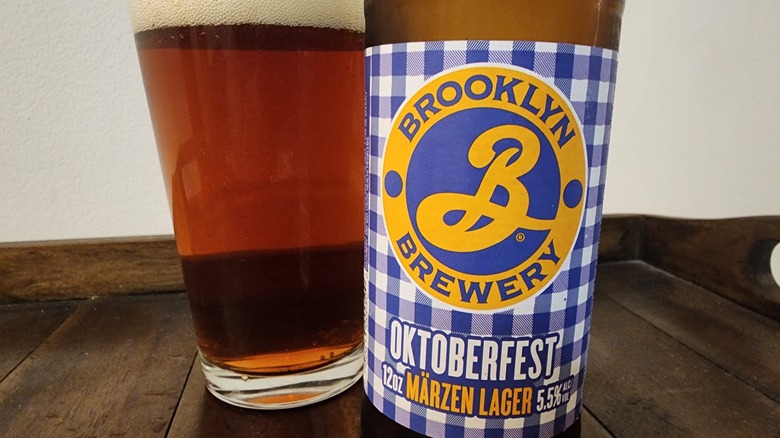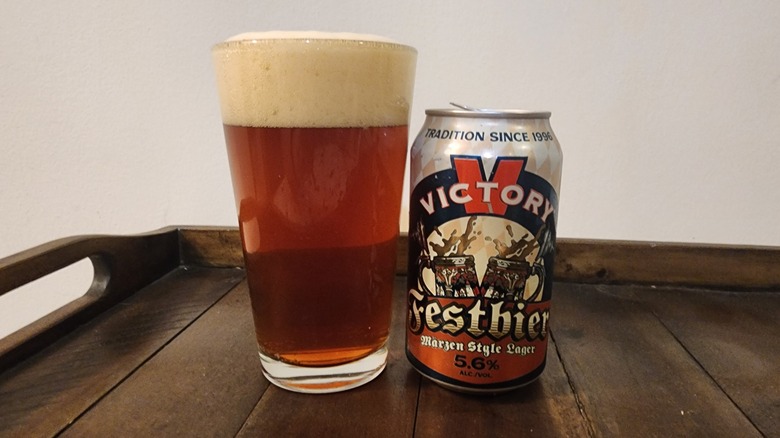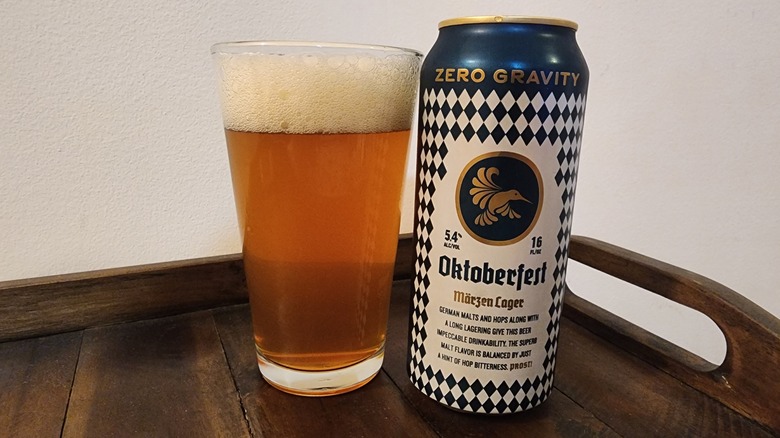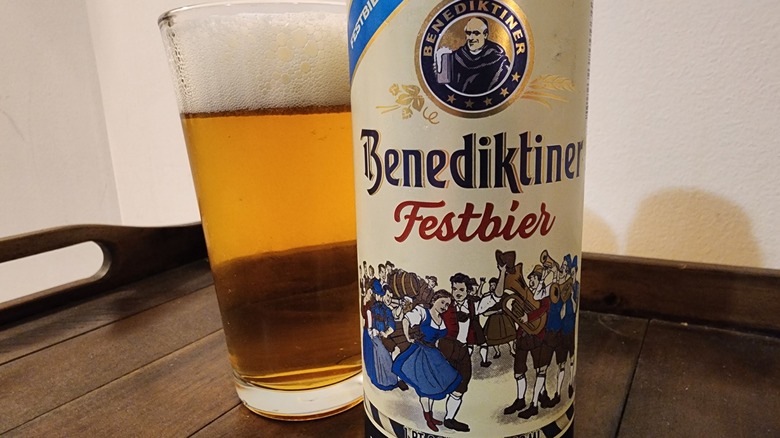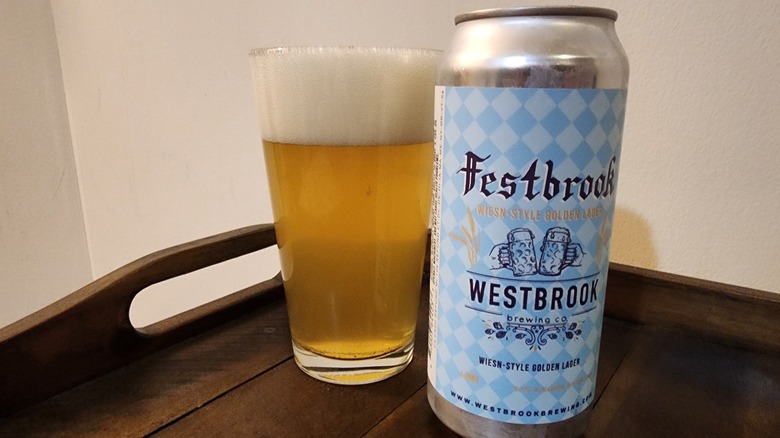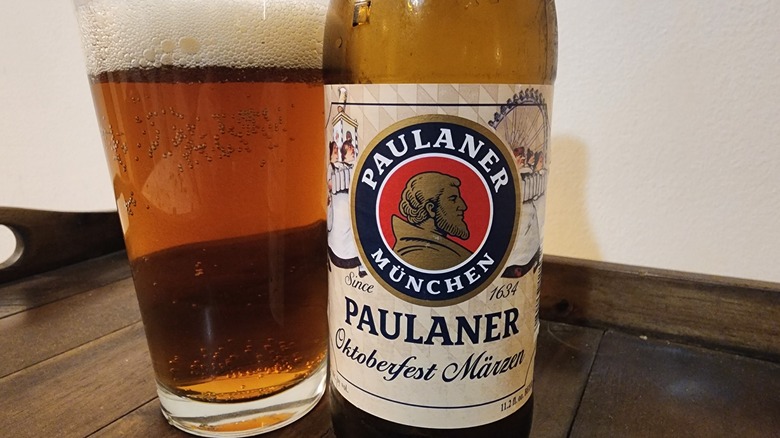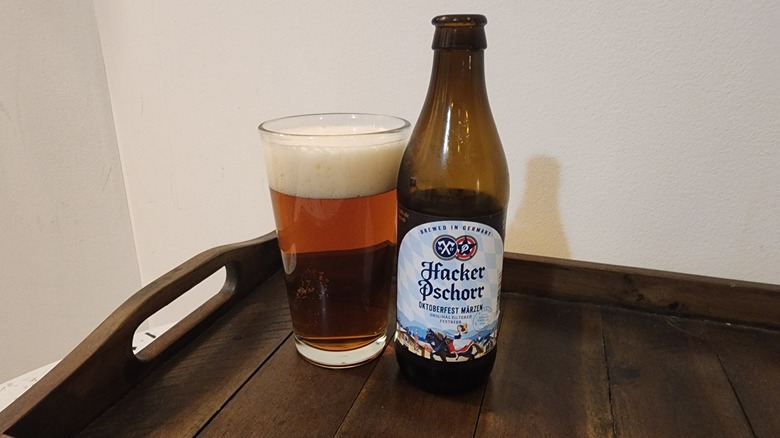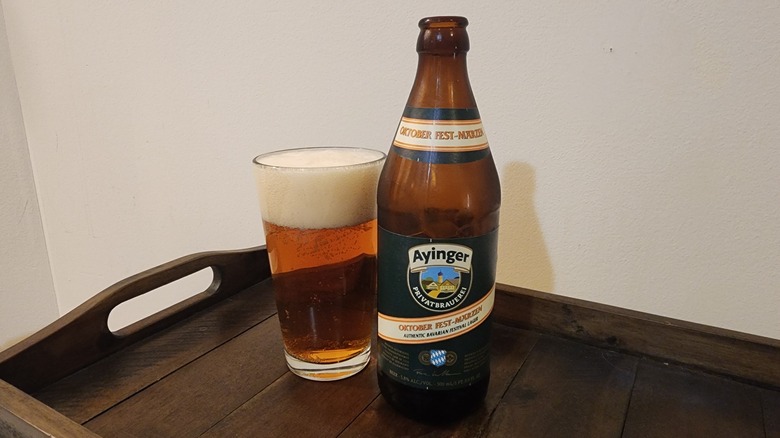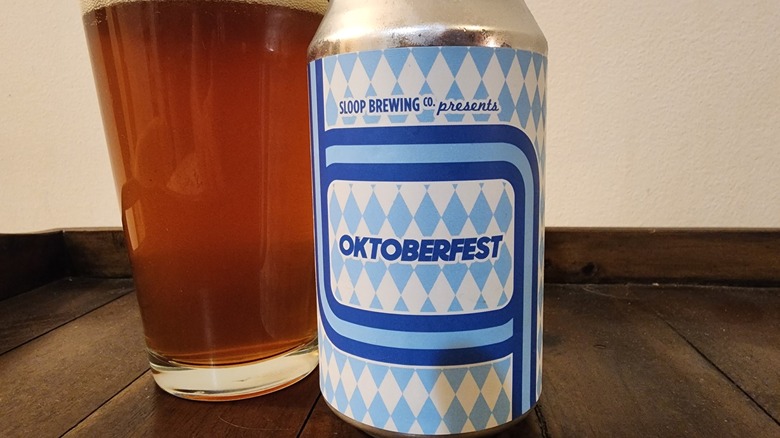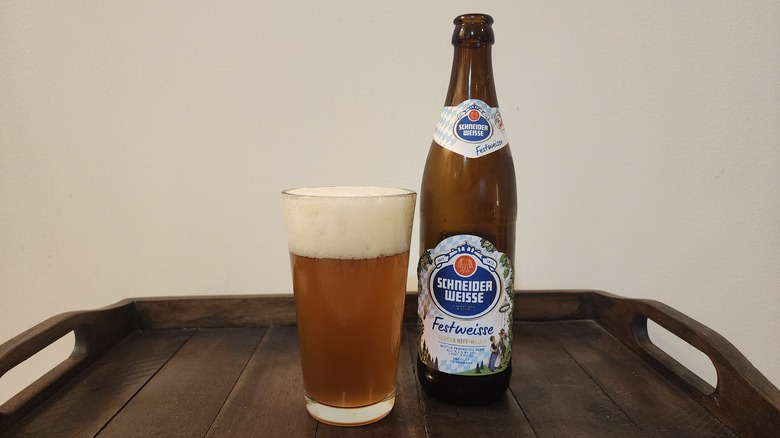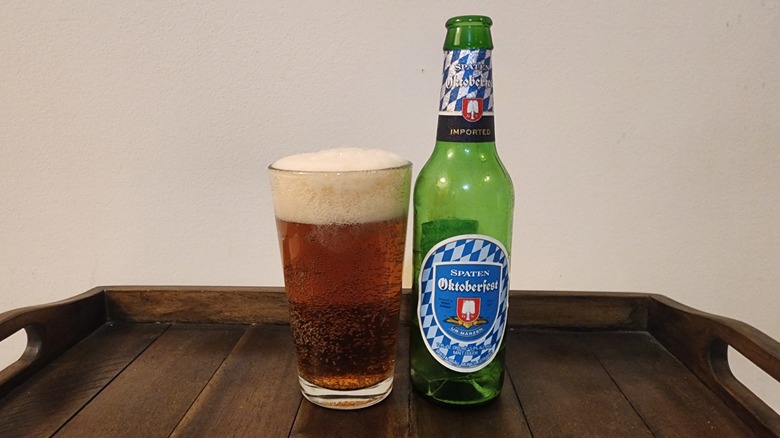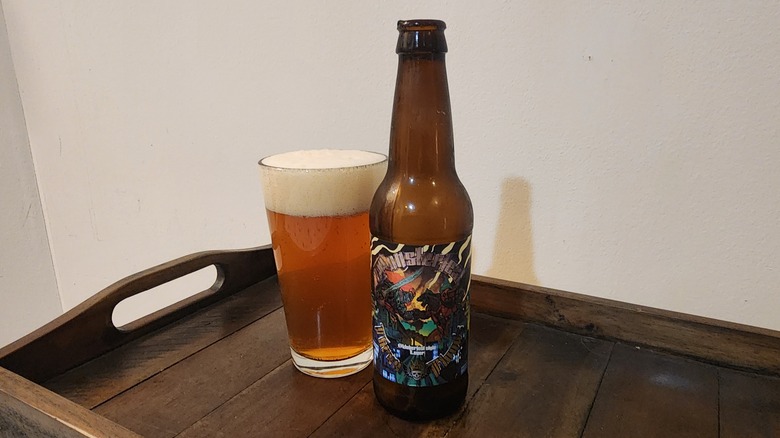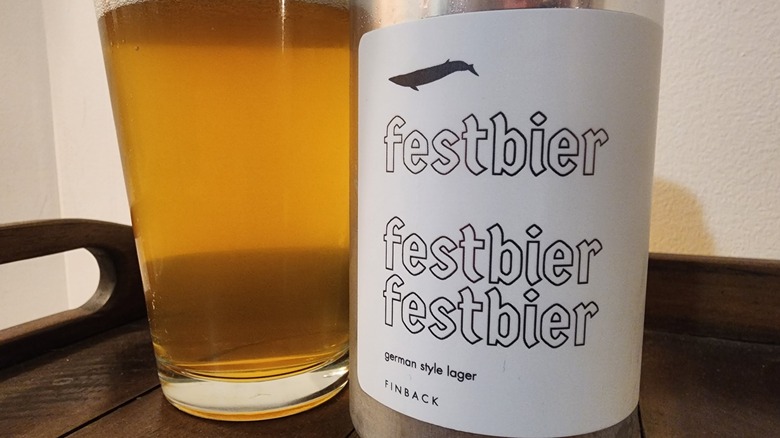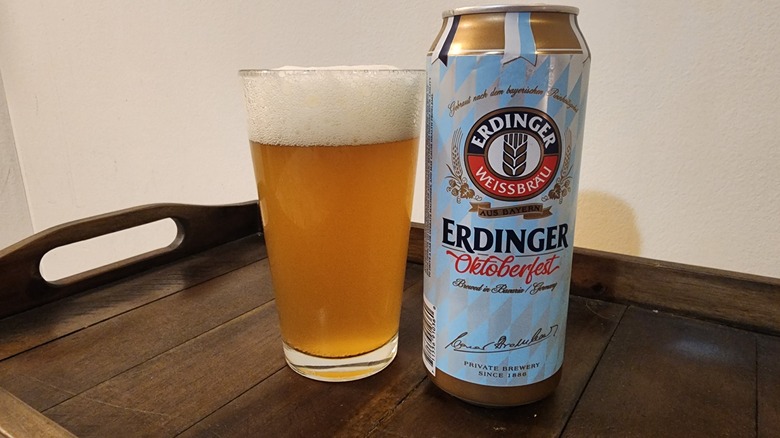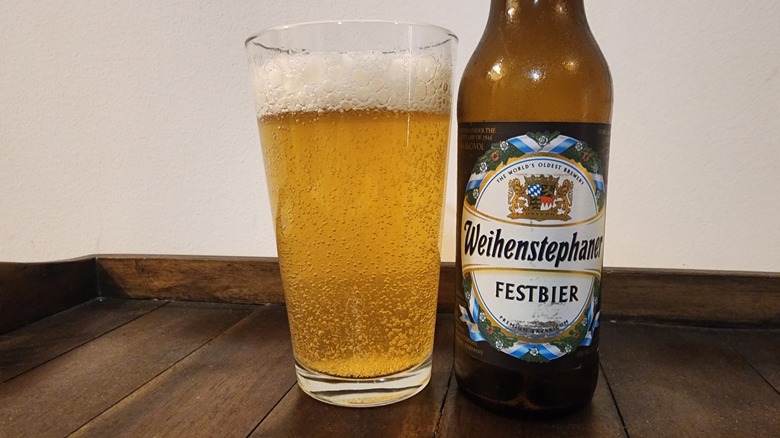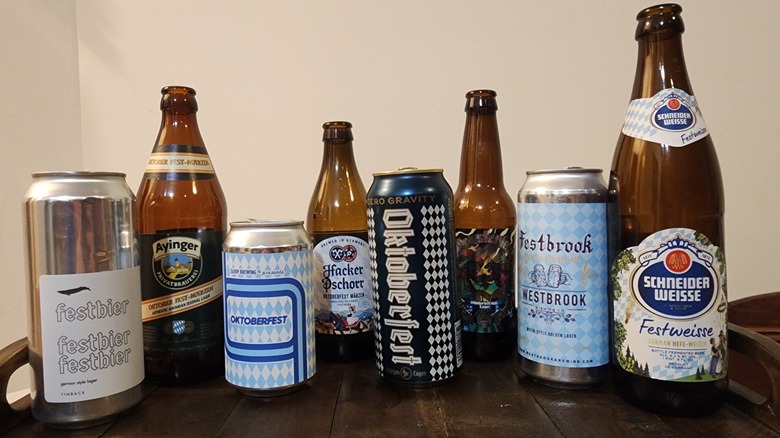Popular Oktoberfest Beers Ranked Worst To Best
More than 200 years old, Oktoberfest remains one of the biggest festivals in the world, attracting around 7 million tourists to Germany each year. The initial Oktoberfest in 1810 was a wedding celebration for Crown Prince Ludwig and Princess Therese of Saxe-Hildburghausen. The citizens of Munich were invited to the celebration, where they enjoyed live music, food, and, of course, beer and wine. The celebration was such a hit, that folks gathered again at the same time and place the following year. Over time, it has evolved into a festival where the main point is to eat, drink, and be merry.
With the explosion in popularity of the German festival has come an equal rise in the popularity of Oktoberfest-style beers. Although each brewery will still have a selection of beers available, the festbier-style märzen ("märzenbier," meaning "March beer") is the standard at the event. These beers, traditionally, were brewed in March and stored in cool caves until ready to drink in the fall.
The event takes place from late September to early October each year. If you're unable to attend Oktoberfest in Munich, to help you celebrate at home, we've sampled a variety of Oktoberfest-style beers to determine the ones most worth buying. All you need to do is head to your nearest store, grab your stein, tankard, or boot, consider cooking up an authentic Oktoberfest recipe, and enjoy.
21. Josephsbrau Oktoberfest
Nothing screams "Oktoberfest" more than Trader Joe's-brand beer, right? Well, not so much, it turns out. While the Josephsbrau märzen-style lager is brewed in San Jose, California, it imports three types of malt from Germany and even abides by the Reinheitsgebot, a historic set of regulations that determine what ingredients can be used in German beers. The brew contains 5.3% alcohol by volume (ABV) and an International Bittering Units (IBU) rating of 25, which falls on the top end of the spectrum for Oktoberfest-style beers (18 to 25, typically). That said, 25 is still low and these beers characteristically are very malt-forward and have little hop (bitter) presence.
The Josephsbrau Oktoberfest has an amber color and filtered appearance — and you certainly get a toasted malt flavor, but I also picked up some other flavors that reminded me more of a pumpkin beer. While I didn't hate the beer overall, it didn't scream "Oktoberfest" to me.
20. Saranac 1888 Octoberfest
This Oktoberfest-style lager, brewed in Upstate New York, like just about every beer on this list, is far from bad — it just doesn't stand up compared to the many others I sampled. The medium-amber brew has only a very slight aroma. And since smell makes up 80 to 90 percent of what we perceive as flavor, that's a bad start. On the first sip, as I expected, I didn't get a strong punch of flavor but with a few more sips I picked up some caramelly, toasted malt flavor. You also get a little bit of hops, which, although not customary, I don't hate. In all, would I try the 5.4% ABV brew again? Sure, but I won't rush out to get it.
19. Shiner Oktoberfest
I liked that the Shiner Oktoberfest leans into the traditional way of making Oktoberfest-style beers — that is, a bit stronger, a bit darker, and with a low carbonation level. That said, not much stood out for this Texas-brewed märzen-style beer. You get a slightly bready aroma and a sweet, malt-forward flavor. But as I put in my notes, "It's not bad, but after all these beers it's not sticking out." If Shiner Oktoberfest is all that's available, it'll get the job done, but there are much better options. It lands here because it has some more traditional characteristics than those below it, but there remain plenty of better options ahead.
18. Toppling Goliath Brewing Co. Oktoberfest
At 5.2% ABV, Toppling Goliath's take on a festival beer has the lowest alcohol content of the nearly two dozen I sampled. Is there anything wrong with that? Not specifically, but it's worth noting. The resulting brew has a deep golden-amber color with a good head. While the bottle claims it's unfiltered and, therefore, may have sediment, I didn't come across any. I also didn't come across much of an aroma or flavor; you get some of the notes you're supposed to but nothing that "wowed" me. I will say, the Iowa-brewed beer is an easy drink and I don't dislike it at all.
17. Lawson's Finest Liquids Fest Bier
Man, ranking this beer so low gives me agita. If you're simply after a really good beer, go pick this one up right now. I have nothing bad to say about Lawson's take on an Oktoberfest-style beer — other than it really doesn't give me Oktoberfest vibes. Thanks to some floral notes from the noble hops that Lawson's uses, you get a complex flavor, which is piggybacked by some toasted malt flavor. The beer has a pale gold color, a seemingly high level of carbonation for this style of beer, and 5.3% ABV. On the nose, you get some wheat, some hops, and a bit of caramel. It's a good beer; it's just not a good Oktoberfest beer.
16. Sam Adams Octoberfest
Sam Adams' seasonal fall beer, to no surprise, is a märzen. It has a reddish amber color, 5.3% ABV, and an IBU rating of 16 — on the lower end of the spectrum. While I found it didn't have a strong scent, it has a very strong honey wheat-like flavor — just what you'd expect. The issue for me is, with such a low hop presence, it's a bit sweet. It's certainly not a sour beer or anything like that, but it's about as sweet as I'd want my märzen to be and, for that reason, it gets ranked in the bottom half.
15. Brooklyn Brewery Oktoberfest
Similar in color to the Sam Adams, Brooklyn Brewery's Oktoberfest beer has a deep red-amber color. From the small but frothy head, you get a very sweet, almost stout- or dunkel-like aroma. While I enjoyed that the beer had a strong aroma, it did make me nervous that it would have too sweet of a flavor. On the taste test, however, I was pleased to find it was malt-forward but not overly sweet in the way I found Sam Adams to nearly be. Again, there's very little hop aroma or presence, making it a bit one-dimensional if not traditional. The Brooklyn märzen lager — which, in my notes, I call "a good beer" — is bottled at 5.5% ABV.
14. Victory Festbier
Supposedly, this Oktoberfest-style beer was the first recipe that Victory Brewing Co. created when it first opened its doors in 1996. Obviously, it was a hit, otherwise I probably wouldn't be here reviewing it 28 years later. The Pennsylvania-brewed märzen has a nice reddish, brownish amber color and a notable aroma of toasted barley, giving it a honey-esque scent. The flavor follows suit with a relatively sweet (but not too sweet) malty essence. It borders on the flavor of a heavier beer, much like the Brooklyn product, giving it an almost chocolatey aftertaste. It's good, but it can't crack the top half of this list.
13. Zero Gravity Oktoberfest
Like Lawson's, Zero Gravity märzen lager has a pretty good hop presence for an Oktoberfest-style beer (IBU rating of 26), but what makes it ranked a few spots higher is that it better balances this with the malty flavor I want in a festival beer. While its first sip is surprisingly hop-forward, that's followed up by a wash of honey-malty sweetness, creating a balanced flavor profile. That said, the fact that this beer is so "untraditional" in its flavor profile, I couldn't rank it much higher — but it definitely checks the "this is a good beer" box. The Vermont-brewed beer has a hazy, golden-amber color and 5.4% ABV.
12. Benediktiner Festbier
Brewed in the German town of Lich, the Benediktiner Festbier has a filtered, pale golden color. It comes in at a more typical 5.8% ABV and has a subtle aroma of hops and malt, as you might expect. The flavor is heavier on the malt side but isn't cloyingly sweet. In fact, for such a "strong" beer, I find it very drinkable. I could definitely enjoy a few of these, whether in a festival tent, at a bar, or at home. That all said, there's a certain something I'm missing from this beer that leaves it lacking that typical Oktoberfest characteristic.
11. Westbrook Brewing Co Festbrook
This South Carolina brewery's weisn-style lager was the strongest of the bunch at 6.5% ABV. Veering into IPA levels of alcohol content, this beer may also worry some who read that it's "extra hopped." While I love IPAs, I've already put a few of the more bitter beers lower on this list, as that's not the traditional flavor profile for a festbier. That said, Festbrook stands out among the bunch.
It has a pale, hazy color (like more modern festival beers) and a bit of a hoppy aroma on the nose. The first flavor you pick up is those hops, but then comes a strong punch of caramelly, malted barley. From the color and aroma, I was not expecting this and was quite surprised. It was a shockingly complex beer. If you're after a good, funky beer, this is it. If you want the best Oktoberfest-style beer, there are some better options ahead.
10. Paulaner Oktoberfest Bier
As a Munich brewery, Paulaner is one of six that can use the "Oktoberfestbier" title. Not surprisingly, it fits the traditional characteristics of a festival lager. The "bier" has 5.8% ABV, a reddish/brownish amber color, a really strong aroma, and a heavy flavor profile. On the nose, I picked up malt and hops — both sweet and bitter. On tasting, you get just a little bit of that bitterness to cut through the toasted malt flavor. It would absolutely do the trick on a cool, autumn day, especially if you're drinking outside. My one qualm: I don't think I would want too many of these.
9. Hacker-Pschorr Oktoberfest
Yet another member of the six Munich breweries that can officially claim the "Oktoberfestbier" title, Hacker-Pschorr doesn't disappoint. Like the Paulaner, it has a dark amber color and is 5.8% ABV. It has a fairly clear appearance and a good bit of head. I liked that I got a good scent of caramelly, toasted barley on the nose, with only a slight hop presence. Those exact notes can be detected in the flavor profile, with a good, bready, malty flavor. The texture also stood out among the beers I sampled. As I've said, I would drink most of these beers again — so they're all pretty good — but in the top 10, you're splitting hairs when making decisions.
8. Ayinger Oktober-Fest Märzen
Brewed and bottled in Aying, Germany, this is an authentic Bavarian festival lager (although it's not brewed specifically in Munich). I loved that when I was pouring this beer, I immediately got a strong malt aroma — like dark bread. In the smell test, I got the same toasted, malty notes. In tasting, I found the beer to follow through with a similar flavor profile. While there was almost no bitterness, the Oktober-Fest Märzen was also not overly sweet. While not my favorite, it's still a really solid example of what a festival beer should be and plenty better than most other options on this list.
7. Sloop Brewing Co. Oktoberfest
Another Upstate New York brewery makes the list — this time cracking the top 10. Despite this hailing from the States, this has all the makings of a good fall beer. The märzen has a dark reddish amber color, an aroma of bread and honey, and a flavor profile of caramelly, toasted malt. You will pick up almost no bitterness. The Oktoberfest-style beer has an ABV of 5.5%.
Sometimes when you're ranking so many food or drink items of a similar category, it can get a bit tough to differentiate them after a while, so you need to rely on a simple test; in this case, how many sips of this did I take before I determined it was time to move onto the next beer? The answer: quite a few.
6. Schneider Weisse Festweisse
Schneider Weisse touts itself as Bavaria's oldest wheat beer brewery. Leaning into that history, the Festweisse is a German hefeweizen, rather than the märzen style found throughout most of this list. While these are the two most common beer varieties, you can come across a wide range of German beer styles at Oktoberfest.
Coming in at 6.2% ABV — the second strongest on this list — and an IBU rating of 28 (the highest among those I could confirm the rating for), Schneider Weisse absolutely gives off Oktoberfest vibes. It has a hazy, deep golden color with a nice, biscuity aroma. When sipping it, you'll first get a strong roasted malt flavor, backed by a hint of citrus. And, despite this hefeweizen's ABV, it's super drinkable.
5. Spaten Oktoberfest
Spaten is the third — and final — of the six breweries that can officially call their brew an Oktoberfestbier that I taste-tested. (The other three, Agustiner, Hofbräuhaus, and Löwenbräu, were not available at stores near me; although Hofbräu would certainly be near the top of this list.) Spaten Oktoberfest has a wheaty, caramelly aroma, with a subtle hop scent. The taste test doesn't disappoint with another malt-forward punch, backed by slight bitterness — which I like, as it breaks up the potential monotony of a single flavor profile. In all, it makes for a super smooth beer. It has a typical 5.9% ABV and an amber color.
4. 3 Floyds Brewing Munsterfest
Sometimes by a label, you can just tell if you're going to like a beer. I know, I know, "Never judge a book by its cover." And judging by this label, I knew I was going to hate this beer. Well, clearly I was wrong. 3 Floyds' Munsterfest is a märzen-style festbier with a deep golden color and a not-quite-hazy appearance. While I didn't get much on the nose, the taste test revealed a balanced flavor profile. In my notes, I wrote, "It's like your favorite wheat beer kicked up a notch."
It's a little wheaty, a little sweet, not too malty or caramelly, and not many hop flavors, but it all rounds out to a super flavorful brew. And unlike some of those listed on the lower half of this list, this Chicago-brewed beer still has the right amount of Oktoberfest vibes. It's bottled at 6.2% ABV and has an IBU rating of 20.
3. Finback Brewery Festbier
On the complete opposite end of the "how busy is your label spectrum" from 3 Floyds, Finback Brewery's minimalistic cans are not indicative of the flavor they pack inside. The German-style lager, which is brewed in Queens, New York, has a pale golden color, a clear, filtered appearance, and a good bit of head. While I didn't find it to have too strong of an aroma, I detected a subtle, honey-wheaty nose. In tasting it, you get those same notes, plus a bit more malt and some bitterness from the hops. Like 3 Floyds, it's just an all-around good beer that deserves a high ranking. Also similar to 3 Floyds, it has an ABV of 6% (although a lower IBU rating, at 15).
2. Erdinger Oktoberfest
We're back to Bavarian-brewed beers with Erdinger's Oktoberfest offering. This weissbier has a golden, almost-hazy color, and a slightly sweet aroma. I liked that this one had a unique flavor compared to all the beers I sampled. You get some sweet malt flavor, but not as caramelly and toasted as some others; you get a noticeable level of hops, too, which I find makes for a more rounded-out, complex beer. In fact, Erdinger's yeast is "specially cultivated in the brewery", which it claims makes the beer "absolutely unique." Perhaps not as popular as some other breweries on this list, Erdinger makes a great Oktoberfest beer.
1. Weihenstephaner Festbier
Taking the crown is Weihenstephaner's Festbier. Yet another Bavarian brewery, Weihenstephaner touts itself as the world's oldest brewery, having been in operation for almost 1,000 years — and that know-how is evident in this product. This pale golden lager has a malted barley-forward flavor, but also a good hop presence as far as a festbier goes, giving it a more rounded-out flavor profile. The festbier is bottled at 5.8% ABV and has an IBU of 26, just outside the high range typically associated with Oktoberfest beers. I really enjoyed the slight honey/caramel flavor that comes from the malt, as well as the slight hop notes in the aroma. In all, this super smooth festbier is the one I'd want to come back to again and again.
Methodology
I tried to test a variety of Oktoberfest-style beers — both in terms of origin and beer type. Most of those on this list are märzens, but that's simply because that's the most typical festival beer. Some on the list are among the classic Munich breweries, others come from Bavaria, and yet others from further abroad in Germany. The remainder are brewed in the U.S. — and while I'm based in New York, I tried to find a representative group of other breweries — be they in Illinois, Vermont, South Carolina, or elsewhere.
In the ranking, the primary factor was flavor, with an immediate secondary factor being how appropriate of an Oktoberfest-style beer it was. Some on this list checked one of those two boxes, and so they were not ranked high. The color, aroma, ABV, ingredients, and the like were all noted to help you determine if the beer might suit your preferences, but they did not weigh heavily in the ranking. I could have expanded this list to 30 or more beers but found this selection to be a fair representation of what anyone located across the U.S. might find at their local beer distributor.
